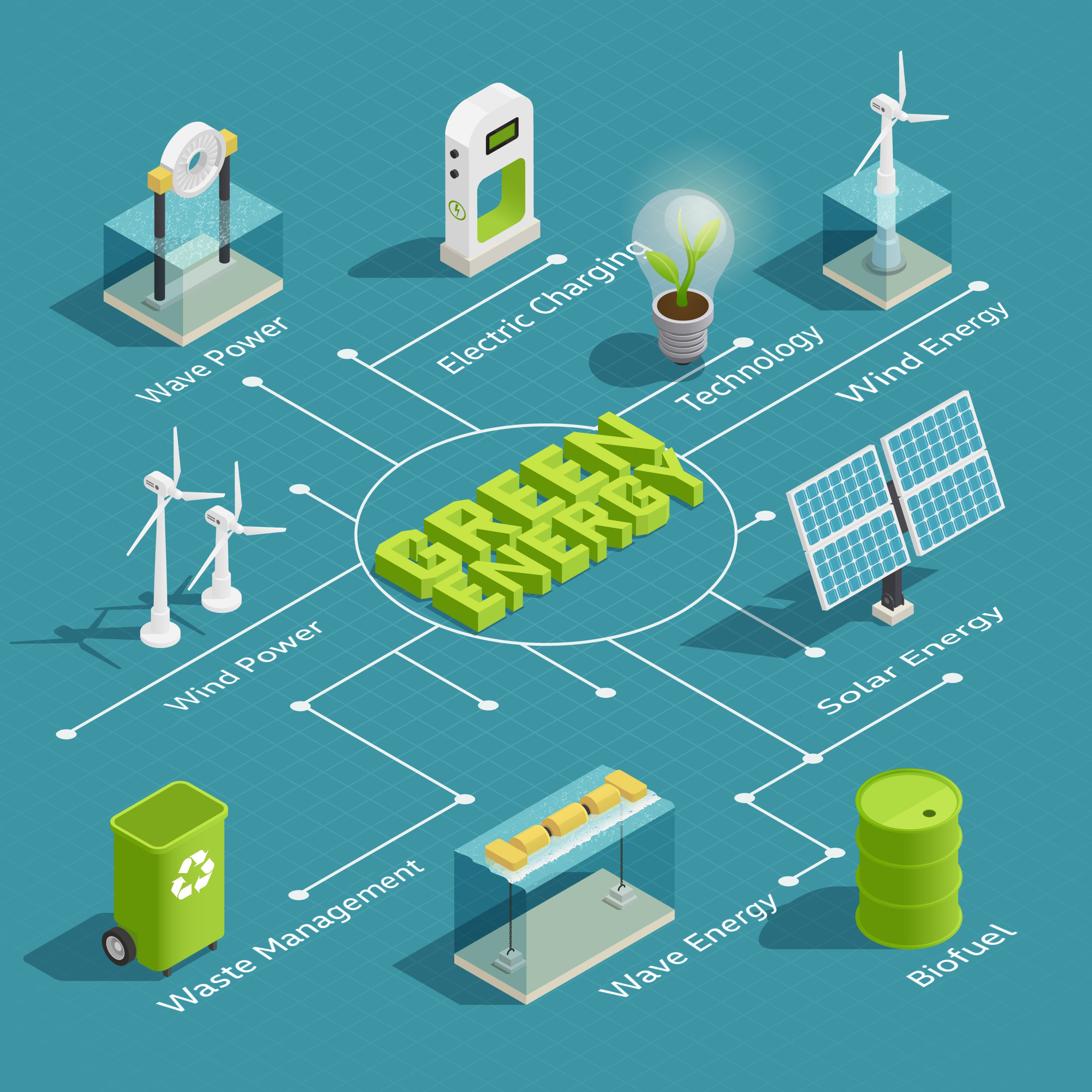
The search for sustainable energy alternatives has intensified in recent years due to the growing urgency to combat climate change and reduce reliance on fossil fuels. Green Hydrogen is the future fuel, emerging as a promising solution. In this blog post, we will explore the potential of Green Hydrogen, its benefits and challenges, and the role GreenH Electrolysis, as a leading manufacturer of PEM electrolysers in India, will play in advancing hydrogen technology as a sustainable energy solution.
Green hydrogen is hydrogen produced using renewable energy sources like wind, solar, or hydropower through a process called electrolysis. Electrolysis involves splitting water into hydrogen and oxygen using electricity. When this electricity comes from renewable sources, the hydrogen produced is considered “green” because it is entirely free of carbon emissions. This contrasts with “grey” hydrogen, produced from natural gas and associated with significant carbon dioxide emissions.
Green hydrogen is highly versatile. It can be stored as a gas or liquid, transported easily, and used in various applications, making it a valuable tool in the shift towards a sustainable energy system.
One of the most significant advantages of Green Hydrogen is its potential to reduce greenhouse gas emissions. Green Hydrogen produces only water vapour as a by-product when used as a fuel, making it an attractive alternative to fossil fuels. According to a 2022 report by the International Energy Agency (IEA), switching to green hydrogen in sectors like transportation, industry, and power generation could reduce global CO2 emissions by up to 6 gigatonnes annually by 2050.
Green hydrogen offers an unparalleled sustainable solution to complement renewable energy installation and help balance electricity grids by storing excess renewable energy. During low grid demand and high renewable energy output, the surplus renewable energy can be used to produce hydrogen. This hydrogen can later be converted back into electricity when grid demand is higher than the direct renewable energy output or used in other applications, providing a flexible energy storage solution.
GreenH Electrolysis is a crucial player in making this process more efficient and scalable, ensuring a stable supply of clean energy.
Why Batteries Aren’t Enough for a Clean Energy Future
Batteries, particularly lithium-ion batteries, have been widely adopted for energy storage and powering electric vehicles. However, they have limitations that make them less suitable for some applications:
- Limited Energy Storage Capacity: Batteries are excellent for short-term energy storage but are not efficient for long-term storage due to energy loss over time and capacity degradation. Green hydrogen, however, can be stored for longer periods of time without significant energy loss, making it a better option for storing energy generated by renewables for extended periods.
- Energy Density Issues: Battery technology has improved significantly in the past few years, making it a viable solution for smaller, low-range vehicles. This has resulted in the wide adoption of battery-electric vehicles for two-wheelers, three-wheelers and four-wheelers traditionally plying within city boundaries. However, batteries remain an unviable solution for long-range vehicles. Air and ocean transport are also outside the purview of current battery technology because of weight, energy density and capacity degradation issues. Hydrogen offers significantly higher energy density compared to batteries, making it far more suitable for energy-intensive applications like long-haul trucking, shipping, and aviation. With the highest calorific value among common fuels—up to 142 kJ/g—hydrogen contains approximately three times the energy of petroleum and 4.5 times that of coal. If utilized in a hydrogen-based battery, it could achieve an energy density of around 40 kWh/kg, vastly outperforming the typical lithium-ion battery’s 0.25 kWh/kg and even fuel oil’s 12 kWh/kg. This exceptional energy density enables hydrogen to store more energy per kilogram, a critical advantage for heavy-duty and long-distance transport solutions.(Source)
- Raw Material Limitations: Manufacturing batteries is a complex chemical process requiring specific raw materials like Lithium, Cobalt, Nickel & Graphite. The extraction and processing of these raw materials have significant environmental impacts due to mining and refining processes. The availability of these raw materials is not uniform across the globe and mining and processing are concentrated in certain countries which exposes the production to geopolitical risks. Exploration and production of new mines is an expensive and lengthy process. (Source)
Green hydrogen production in contrast relies mainly on water and renewable electricity, offering a more sustainable and scalable solution.
- Recycling: Battery recycling is an important step contributing to the long-term viability of battery solution for decarbonisation. This helps limiting the negative externalities like end of life landfill burden, mining of natural resources and the greenhouse gases emitted during the process. Battery recycling itself, however, faces significant challenges. It is an expensive process with insufficient guidelines for safe handling. Also, different kinds of batteries require different recycling processes which further limits the scale, costs and efficiency of recycling Whereas, recycling materials like platinum and other rare metals used in electrolysers is easier due to well-established recovery processes, as well as a higher recovery rate for these metals.
The Unique Advantages of Green Hydrogen Alternative to Batteries
Green hydrogen provides several unique benefits that make it a valuable addition to the clean energy mix:
1. Decarbonizing Hard-to-Electrify Sectors of Transportation
In transportation, hydrogen fuel cells are ideal for heavy-duty vehicles like trucks, buses, and ships, where battery electric solutions face limitations due to low energy density, driving range and refueling time. Hydrogen-powered trains are already operating in Germany and Japan, and companies like Toyota and Hyundai are developing hydrogen fuel cell vehicles to meet the needs of longer-range and heavy-duty transportation.
India also has taken long strides in the direction of hydrogen-based transport. India’s first hydrogen fuel cell bus was launched in September 2023, by India’s Minister of Petroleum and Natural Gas, Shri Hardeep Singh Puri.
Indian Railways has joined the league of nations that has announced hydrogen trains. GreenH is responsible for the hydrogen production and refuelling station for the first hydrogen train in India.
2. Long-Term Energy Storage and Grid Stability
Renewable energy sources like wind and solar are inherently intermittent, meaning their output fluctuates depending on weather conditions and time of day. This variability creates a need for storage solutions that can capture excess energy during periods of high production and release it when demand is greater or generation is low. While batteries are effective for short-term storage, they lose efficiency over time. Green hydrogen, on the other hand, can be stored for extended periods without significant energy loss, making it a dependable choice for long-term energy storage.
By producing green hydrogen during times of surplus renewable energy, it can be stored and later utilized to balance the grid, ensuring a steady and reliable energy supply. This capability is particularly vital for countries striving to increase the share of renewable energy in their power grids.
3. Enabling Energy Export and Reducing Dependence on Fossil Fuels
Countries with abundant renewable energy resources, such as Australia, Chile, and Saudi Arabia, view green hydrogen as an opportunity to export energy. Green hydrogen can be produced locally using renewable resources and then exported to countries that lack such resources, creating a new global energy trade and reducing dependence on fossil fuels.
This also enables decentralized energy production, where communities can generate and store their own energy independently of the central grid. This could enhance energy security, reduce transmission losses, and promote local economic development.
4. Life Cycle Emissions
Although both battery electric vehicles (BEV) and Fuel cell electric vehicles (FCEV) are considered zero emissions vehicle, fuel cell electric vehicles fare considerably better in terms of emissions calculated over the complete life cycle of raw material extraction to end-of-life disposal. (Source)
Green Hydrogen and Batteries: A Powerful Combination
Rather than competing with batteries, green hydrogen should be viewed as a complementary technology in the clean energy landscape. Batteries are great for short-term energy storage and light-duty applications, while green hydrogen excels in long-term storage and heavy-duty sectors that batteries can’t easily reach.
GreenH Electrolysis is advancing green hydrogen technology by developing efficient and cost-effective electrolysers. These innovations are crucial for reducing the costs associated with green hydrogen production and expanding its use across various sectors.
Conclusion
Green hydrogen is indeed a key element of clean energy, offering solutions to some of the most challenging aspects of the energy transition. With its ability to decarbonize hard-to-electrify sectors, provide long-term energy storage, and support grid stability, green hydrogen is set to play a critical role in our sustainable energy future. As technology advances, costs fall, and infrastructure develops, green hydrogen will become increasingly important in achieving global climate goals.
By understanding the unique advantages of green hydrogen and supporting its development, we can build a more robust and versatile clean energy system that meets the needs of a sustainable future. For more insights into renewable energy technologies and their potential impacts, explore our other blog posts on this topic.
